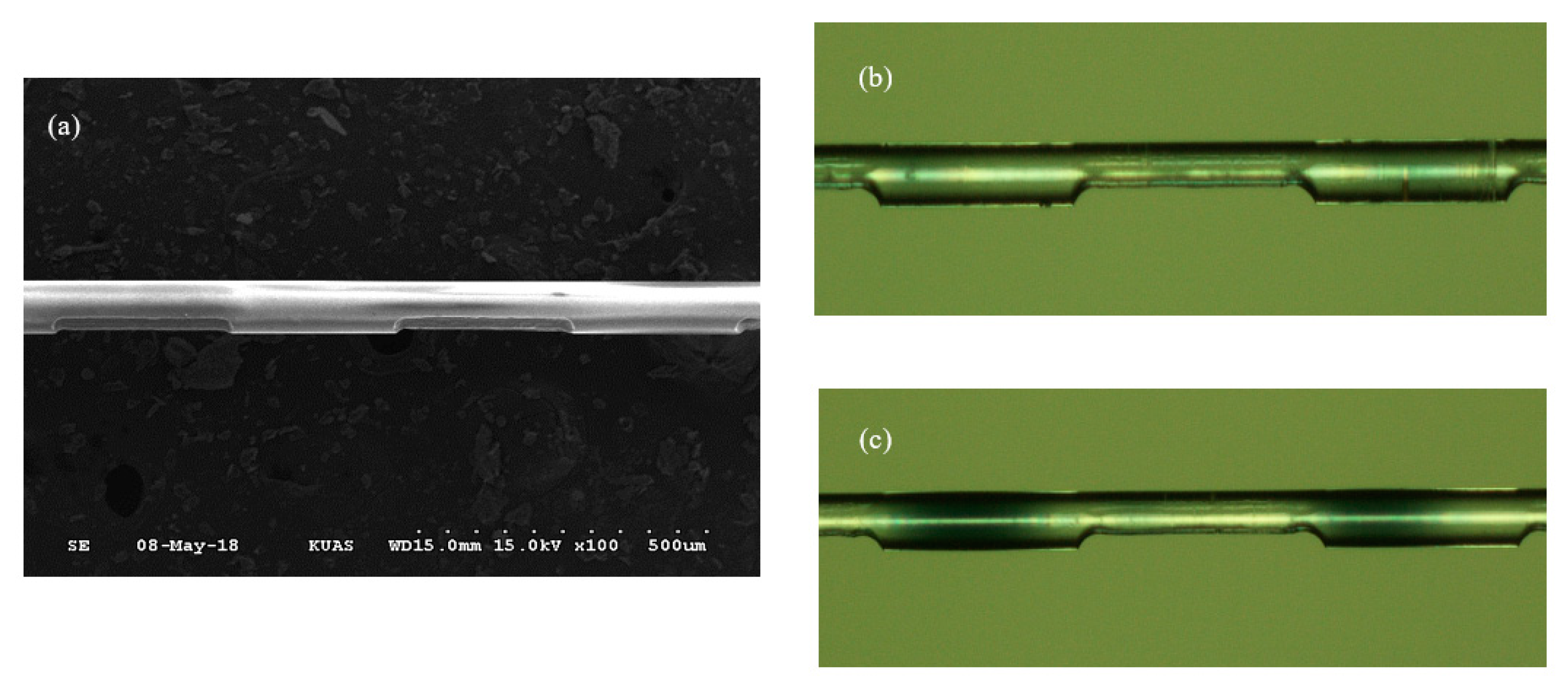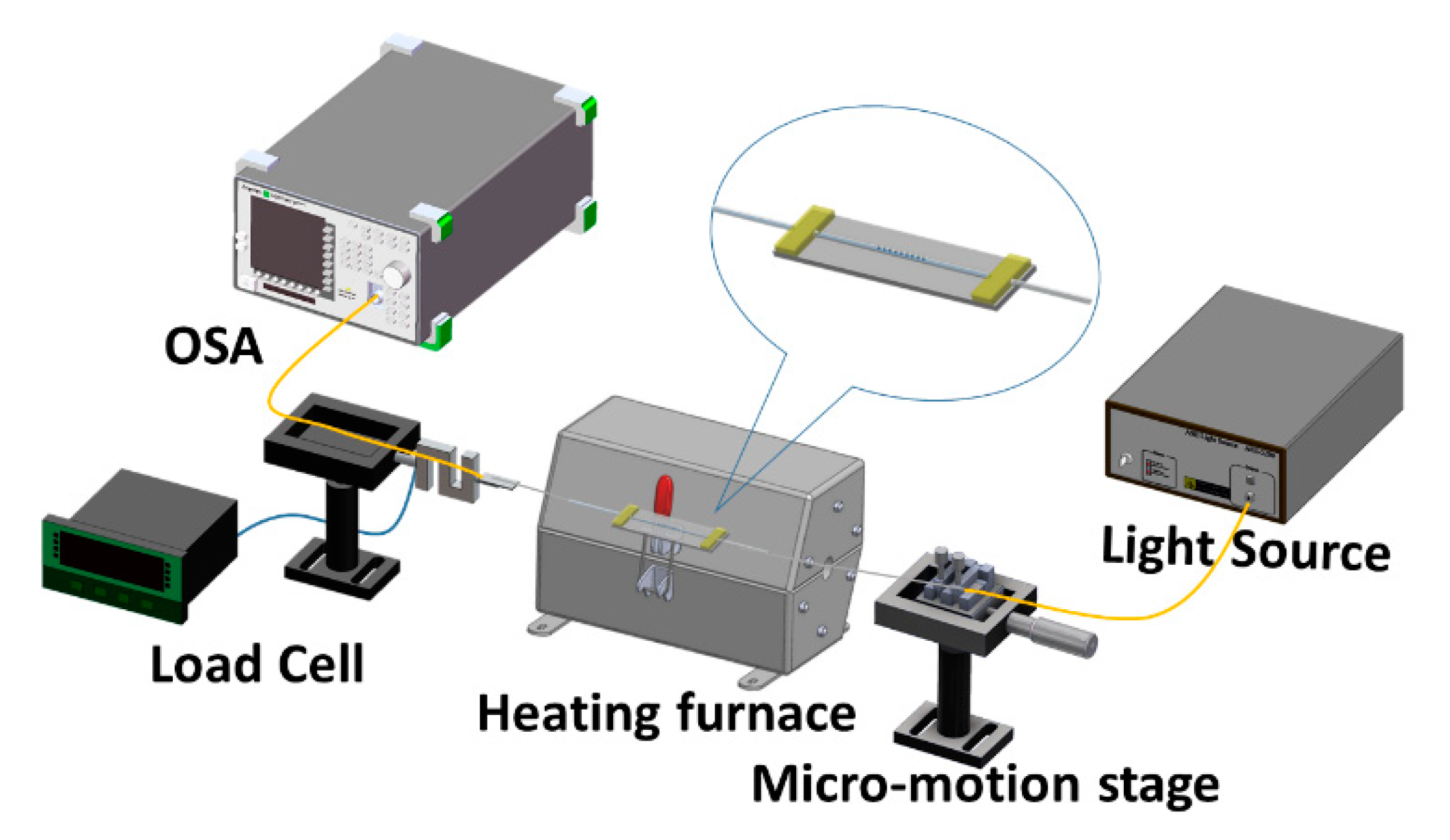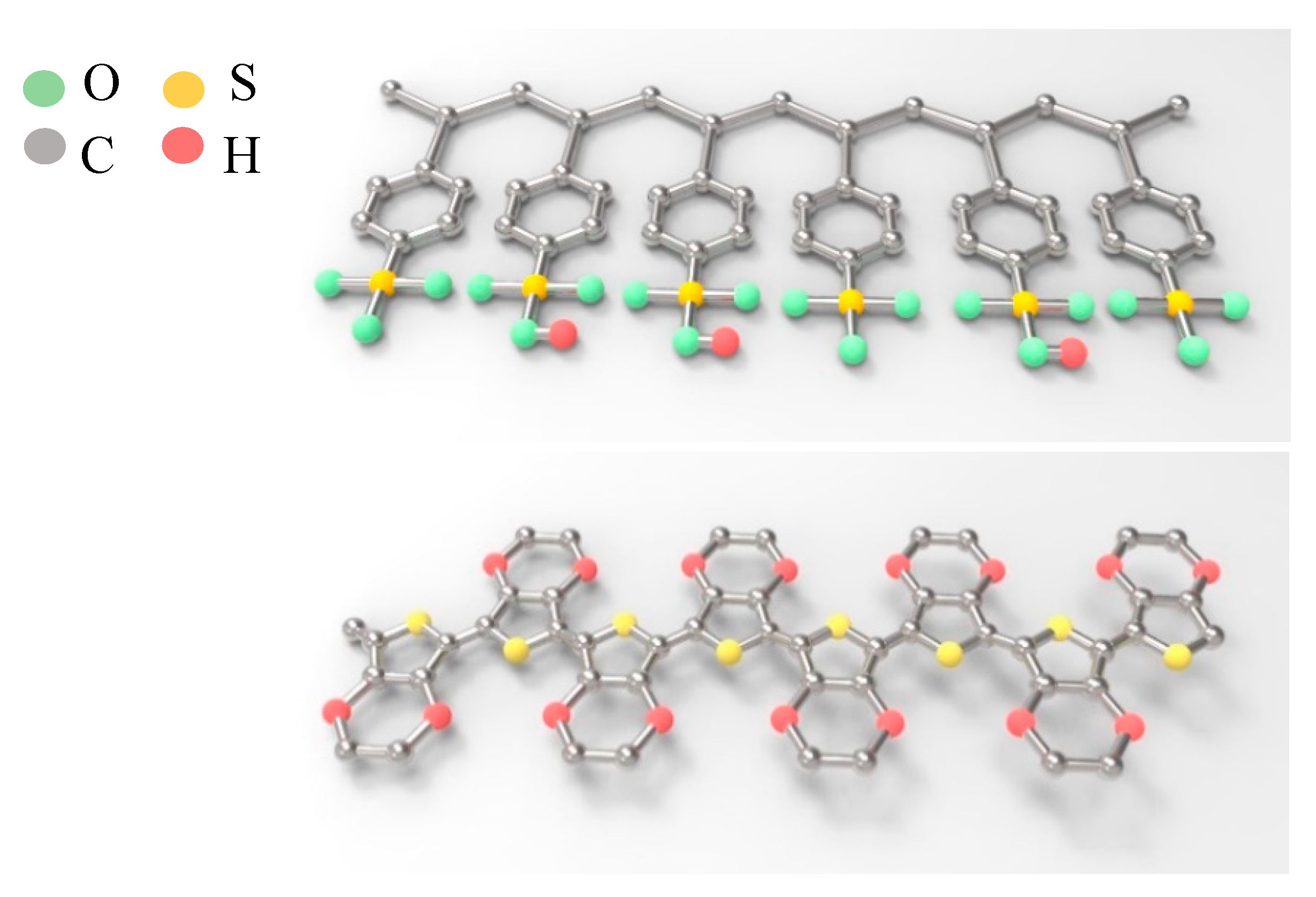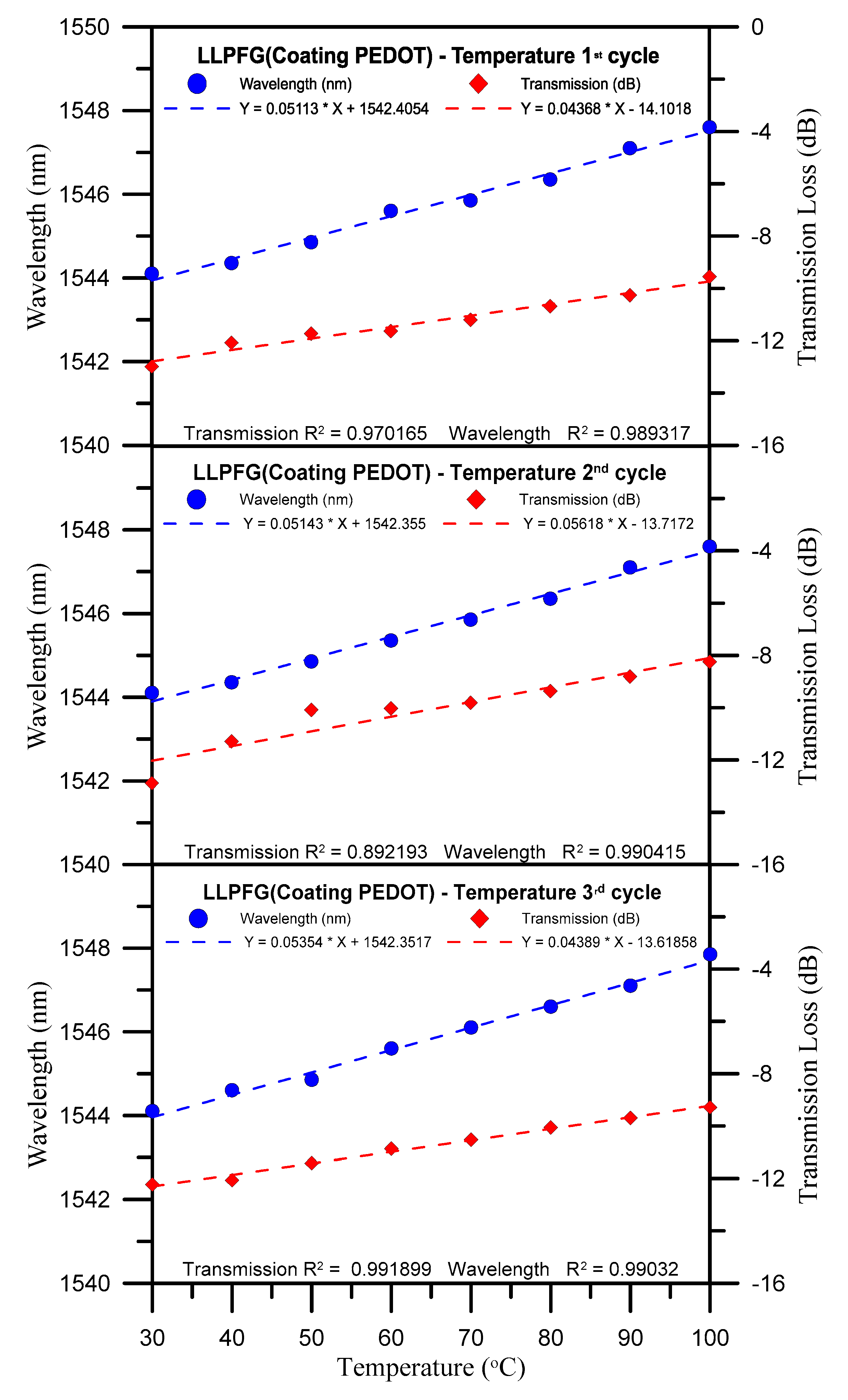1. Introduction
Recently, there has been considerable interest in fiber grating refractive index (RI) sensors because of their high sensitivity, efficiency, and light weight. In particular, close attention has been paid to long-period fiber gratings (LPFGs), particularly to the way in which light at the resonant wavelength of an LPFG is coupled from the guided to the cladding modes, which causes energy loss depending on the difference between the RI of the guided and cladding modes. For this reason, the previous study proposes a laser-assisted-etching LPFG (LLPFG) sensor fabricated using an excimer laser and metal photomasks, examines the effects of temperature on wavelength drift and transmission loss, and explores the use of LLPFG sensors for temperature sensing [
1,
2].
This type of functional coated layer is frequently employed as a feature in optical fiber sensors. A functional group of materials portrays a chemical or physical reaction with a purpose, for example, a small molecular structure grown layer-by-layer via deposition, or solution coating manufacture of a polymolecular structure by sol–gel or dip coating [
3,
4,
5].
In 2008, Ding et al. [
6] utilized reactive ion etching to etch a long-period grating structure on a tapered optical fiber; the etched structure had a length of 11 mm, a fiber diameter of 15 µm, and a long-period distance of 200 µm. In addition to the fabrication of a long-period grating structure through reactive ion etching, that study also examined the relationship between the tapered optical fiber’s resonant wavelength and etched fiber diameter. Through a comparison of the measured and calculated transmission spectrum values, it was found that multimodal coupling occurred only between two neighboring tapers and at the boundaries of the LPFGs. In the same year, Zhao et al. [
7] inscribed a long-period structure on a photonic crystal fiber and used it to measure strain. The measurement method involved adhering one end of the long-period structure to a fixed platform and the other end to a mobile micromotion platform such that the micromotion platform was used to control displacement and thus measure strain at a resolution of 0.3 με.
In 2012, Chiang et al. [
8] proposed an LPFG fabricated using inductively coupled ion etching. This primarily involved the use of photolithography to imprint a periodic structure on a photoresist to be imposed on an optical fiber. The coupled plasma ion etching process was then performed, during which the photoresist served as a barrier layer. An etch rate of 0.35 μm per minute was achieved. Subsequently, the structure was placed in sulfuric acid to remove the photoresist and obtain LPFGs with certain periods that had stable verticality. A comparison with wet etching results indicated that the coupled plasma ion etching process offered superior etching stability and accuracy.
Given the broad potential of temperature transducers across various commercial and industrial fields, Singh et al. [
9] proposed an LPFG temperature transducer in 2014. This LPFG temperature transducer can respond to the various peak resonance wavelength shifts corresponding to the various attenuation bands of transmission spectra. After studying the effects of temperature on the various attenuation bands of the LPFG, a highly sensitive measuring device was developed. Subsequently, after monitoring the wavelength shift of each peak resonant wavelength in response to temperature increments of 20 °C, it was found that, with respect to the temperature sensitivity of various attenuation bands, the LPFG had a grating period of 280 μm within the wavelength range of 1.1–1.7 nm (0 to 100 °C). In 2015, Wu et al. [
10] proposed a temperature measurement experiment that involved the use of an LPFG with a nanostructure. In this experiment, an increase in temperature was accompanied by the red-shifting of wavelength positions and a gradual increase in loss; with a diameter of 45 µm and period of 620 µm, the wavelength’s temperature sensitivity was 0.0693 nm/°C, and the sensitivity of loss in response to temperature was 0.043 dB/°C.
In 2015, Bai et al. [
11] proposed the fabrication of long-period structures using a welding machine and a cutting head. In that study, a welding machine (eccentricity was set to 3 μm) was used to weld three segments of LPFGs with a period of 586 μm. When temperatures from 20 to 800 °C were measured, the LPFG was found to have a loss sensitivity of 0.00123 dB/°C and a wavelength sensitivity of 0.0977 nm/°C; however, from 800 to 1000 °C, the LPFG was revealed to have a loss sensitivity of 0.0199 dB/°C and a wavelength sensitivity of 0.2652 nm/°C. In 2018, Zhang et al. [
11] proposed the use of a femtosecond-calibrated CO
2 laser to fabricate an all-fiber dual-parameter transducer with a cascaded long-period grating, and managed to produce results that contributed to the theoretical and experimental advancement of this field. The resulting LPFGs had a resonant wavelength of 1557.80 nm and 1590.88 nm; within a strain range of 0 to 400 με, the LPFGs fabricated by CO
2 laser (C-LPFG) and by femtosecond laser (F-LPFG) achieved a strain sensitivity of −7.2 and −1.6 pm/με, respectively. Within a temperature range of 30 to 70 °C, the C-LPFG and F-LPFG achieved values of −41.1 and −21.2 pm/°C. After the characteristics of the resonant wavelengths had been analyzed, it was found that the transducer could effectively perform two-parameter measurements, giving it broad applicative potential and enhancing its value as a research reference.
In 2019, Wang et al. [
12,
13] designed a high-sensitivity temperature transducer made from tapered multimode chalcogenide fiber that had LPFGs. From a theoretical perspective, they examined these LPFGs’ transmission characteristics, the temperature sensitivity of their cladding modes, and the changes to their diameters and surrounding refractive indices. The results proved that the LPFGs’ temperature sensitivity values could be effectively increased by reducing their diameters. When a particular LP
02 fiber had a minimum diameter of 75 μm, the corresponding LPFG’s temperature sensitivity per 1.55 μm was calculated to be 1.89 nm/°C. When the grating period of the LPFG was selected at its dispersion turning point, its temperature sensitivity per 1.55 μm reached a maximum absolute value of 15.2 nm/°C, which was approximately 120 times the sensitivity achieved by a tapered silicon dioxide LPFG. In 2020, Wen et al. [
14] proposed a novel square-wave double-sided long-period fiber grating structure through a KrF 248-nm excimer and an aqueous solution of acid. The square-wave period grating structure was caused by an etching rate on the optical fiber surface after a laser-assisted wet etching process. Average resonant wavelength/temperature ratio of the sensor was 0.054 nm/°C, while the transmission loss/temperature ratio was 0.038 dB/°C. This study proposes the application of a conductive polymer in a temperature detector based on an LPFG. The interesting concept of an optical fiber sensor via a conductive polymer functional layer is novel and unpublicized.
2. Theory
Another term for LPFG is transmission fiber grating. Any LPFG has a period of approximately 100 to 1000 μm. When light is being transmitted through an optical fiber, the periodic grating structure can be utilized to determine the phase-matching conditions for the LPFG’s resonant wavelengths using the following equation [
15]:
where
is the resonant wavelength position,
is the grating period,
is the core’s effective refractive index, and
is the cladding’s effective refractive index.
When light passes through the grating region and causes the periodic grating’s refractive index to change, the LPFG’s transmission loss is defined as follows:
where
,
, and
are the LPFG’s coupling coefficients, and
. Thus, Equation (2) can be simplified as follows:
Because the transmission loss of light being transmitted through an LPFG is a cosine-squared function, the magnitude of the LPFG’s transmission loss is determined by the coupling coefficient and grating length (L).
The sensor’s grating period changes in response to thermal expansion or contraction, which, in turn, causes the coupling coefficients to change. The sensing response of the LPFG’s grating period was investigated in this experiment on the basis of this principle.
4. Results and Discussion
The PEDOT:PSS-coated LLPFG sensor was subjected to temperatures ranging from 30 to 100 °C to analyze its sensitivity. The sensor was created with the use of an excimer laser and an iron grating with a 620-μm period, after which BOE was used to wet etch the sensor to a diameter of 65 μm. Following this, the LLPFG sensor underwent tensile testing, during which it was subjected to tensile forces ranging from 0 to 0.0882 N; it achieved its optimal sensitivity at 0.0882 N. Finally, PEDOT:PSS coating and encapsulation processes were performed.
The three-cycle temperature test spectrogram is shown in
Figure 6. During temperature testing, the sensor was exposed to a gradual increase in temperature from 30 to 100 °C over a period of 1 h, and furnace cooling was then used to return the temperature to its original level under stable conditions. As graphed in
Figure 6, the increase in temperature was accompanied by a gradual shift of the wavelength position to a longer wavelength, as well as a gradual decline of transmission loss.
Table 1 also indicates that the wavelength shift was approximately 4 nm. The changes in wavelength shift and transmission loss are listed in
Table 1.
Wavelength losses observed over three temperature test cycles are graphed in
Figure 7. This figure indicates that the sensor’s average wavelength sensitivity and average transmission sensitivity were 0.052 nm/°C and 0.048 dB/°C, respectively (also see
Table 2). As listed in
Table 3, the LLPFG exhibited accurate linearity for wavelength shift and transmission loss, with its average wavelength shift linearity and average transmission loss linearity being 0.99 and 0.95, respectively. These results also indicate that Equation (1) was fulfilled because the optical fiber’s refractive indices (
and
) and wavelength position increased in response to temperature changes. The transmittance of an LLPFG can be expressed with the coupling coefficient between the core and cladding and the grating length. The length of the LLPFG is determined by the overlap integral of the core and cladding modes and by the amplitude of the periodic modulation of the mode propagation constants. When the thermal expansion is applied, the value of
in Equation (3) will change according to the elastic-optic effect. Therefore, the transmittance can be tuned by changing the external expansion. Therefore, Equation (3) was also fulfilled because the grating period changed in response to thermal expansion and contraction, which, in turn, led to variations in the coupling coefficients and gradual increases or decreases in transmission loss.
We also conducted control experiments (the temperature sensitivity of an LPFG without PEDOT:PSS). Wavelength shift and transmission loss sensitivity over three temperature test cycles under LPFG (D = 65 μm, Λ = 620 μm) coated with PEDOT:PSS and LPFG (D = 65 μm, Λ = 620 μm) without PEDOT:PSS (
Figure 8) are similar. However, the LPFG sensor without PEDOT:PSS frequently broke during temperature detection. The polymer plays the role of a protective layer for the sensor, and the polymer can expand and contract with temperature changes during temperature measurement. Therefore, the result can reach similar sensitivity.














